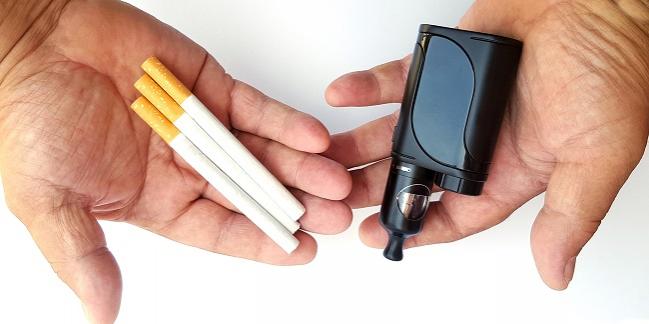E-Cigs in Combination With Cigarettes Don’t Cut Markers of CV Risk
People who used e-cigarettes exclusively, however, looked similar to those didn’t vape or smoke tobacco in the prospective study.

Using some combination of combustible cigarettes and electronic cigarettes doesn’t appear to be a safer option compared with only smoking tobacco when it comes to markers of subclinical atherosclerosis, data from a nationally representative study of US adults shows.
Dual users and exclusive smokers had similar elevations in several inflammatory and oxidative stress biomarkers compared with people who didn’t use either product, according to investigators led by Andrew Stokes, PhD (American Heart Association Tobacco Regulation and Addiction Center, Dallas, TX, and Boston University School of Public Health, MA).
Those who used only e-cigarettes had a biomarker profile similar to that seen in nonusers, Stokes et al report in a research letter published online ahead of print in Circulation. The findings, from the Population Assessment of Tobacco and Health (PATH) study, are consistent with a previous analysis out of the National Health and Nutrition Examination Survey, they note.
“If you’re a patient who uses combustible cigarettes and you’re interested in a path toward harm reduction or cessation, we find that dual use of both products is not an effective means of reducing risk,” Stokes told TCTMD. Instead, he said, the study suggests “that if you are going to use e-cigarettes, you should switch completely and you should have a plan in place with your provider for ultimately attaining freedom from all products.”
E-cigarettes have been available for a relatively short period of time, coming to the US market in 2007, which makes it challenging to study their long-term health effects, Stokes pointed out. To overcome that obstacle, researchers examine earlier stages of disease progression. Preliminary evidence of this type has indicated that e-cigarettes might have adverse CV effects.
If you are going to use e-cigarettes, you should switch completely and you should have a plan in place with your provider for ultimately attaining freedom from all products. Andrew Stokes
In the current study, the researchers zeroed in on biomarkers known to be predictive of adverse CV outcomes in the future. They included a marker of oxidative stress, urinary 8-isoprostane, and four inflammatory markers—high-sensitivity C-reactive protein, interleukin-6, fibrinogen, and soluble intercellular adhesion molecule. “Establishing an association of these markers with tobacco use behaviors is an essential first step to establishing long-term harm,” Stokes explained.
The analysis included 7,130 US adults who provided blood and urine samples as part of the PATH study’s first wave in 2013 and 2014. They were split into four groups based on their cigarette and e-cigarette use in the previous 30 days:
- Exclusive cigarette smoking (29.6%)
- Exclusive e-cigarette use (1.9%)
- Dual use (9.9%)
- No use of either (58.6%)
On multivariate analysis, those who used e-cigarettes alone and nonusers had similar levels of the inflammatory and oxidative stress biomarkers, whereas exclusive smokers and dual users had significantly higher levels of all biomarkers compared with nonusers and similar levels compared with each other.
Stokes stressed that the findings should not be construed to suggest that people who have never used a tobacco product can safely take up e-cigarettes. “We’re not saying that they’re harmless,” he said. “Our results would suggest that if you’re a combustible cigarette user, complete substitution may represent a viable path to harm reduction.” He added that additional larger studies are required to tease out whether exclusive e-cigarette users have any excess risk relative to nonusers, pointing out that small clinical studies and mouse studies suggest there could be adverse effects on the heart.
Commenting for TCTMD, Neal Benowitz, MD (UCSF Center for Tobacco Control Research and Education, San Francisco, CA), said looking at biomarkers is an important way to explore the potential health effects of e-cigarettes.
It’s not surprising that cigarette smokers had higher levels of all of the biomarkers included in this study compared with nonsmokers, or that dual users had a similar profile, Benowitz said. That’s because “most dual users don’t use e-cigarettes very often and they’re mostly cigarette smokers.”
He cited a number of limitations of the study, including the use of blood and urine samples from users of first-generation e-cigarettes that have been supplanted by newer products over the years. The study also lacks information on the frequency of e-cigarette use/smoking and on the prior history of e-cigarette users, which may have relevance for assessing biomarker levels.
What can be taken away from this study, Benowitz said, is that the early e-cigarettes “look like they do not convey significant cardiovascular risk based on these biomarkers.”
That’s reassuring, he said, but added that it’s possible e-cigarettes increase risk in other ways—through the effects of nicotine, for instance. “My research suggests that nicotine itself is not harmful for most people, but if you have underlying cardiovascular disease, it could increase the risk of fatal heart attack or fatal stroke because it increases catecholamine levels and adrenaline levels and can do things that can interact with ischemia to precipitate acute cardiovascular events.” This study, Benowitz noted, cannot address that question.
Stokes acknowledged that the available e-cigarettes have changed over the years, but said there is little evidence to suggest unique effects from newer products. “We think the results are fairly generalizable [to newer e-cigarettes], but more recent data will be required to verify the findings,” he said.
Todd Neale is the Associate News Editor for TCTMD and a Senior Medical Journalist. He got his start in journalism at …
Read Full BioSources
Stokes AC, Xie W, Wilson AE, et al. Association of cigarette and electronic cigarette use patterns with levels of inflammatory and oxidative stress biomarkers in US adults: Population Assessment of Tobacco and Health study. Circulation. 2021;Epub ahead of print.
Disclosures
- The study was funded through the National Heart, Lung, and Blood Institute.
- Stokes reports grants from Ethicon Inc (a Johnson & Johnson Company) outside of the submitted work.


Comments